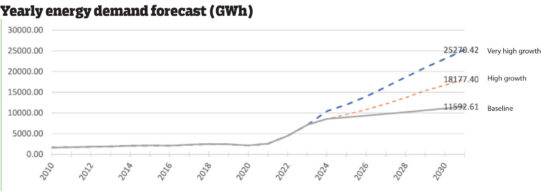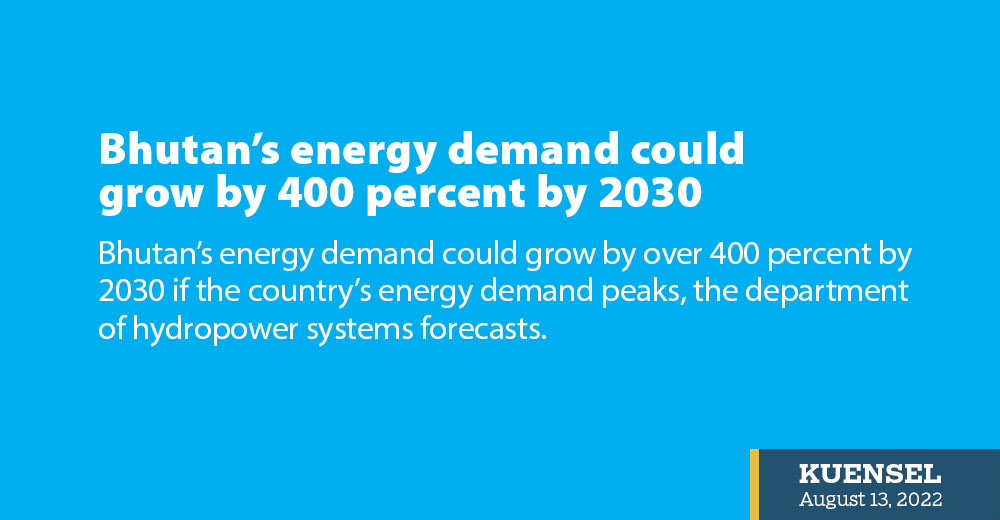Thukten Zangpo
Bhutan’s energy demand could grow by over 400 percent by 2030 if the country’s energy demand peaks, the department of hydropower systems forecasts.
An official from the department of renewable energy (DRE) in the economic affairs ministry, Karma Sangay, at a seminar in Thimphu on August 10 said, “The high energy demand could peak at 25,270.42 Gigawatt hours (GWh) in 2030 from 5,000GWh this year.”
He said the energy demand from 2010 to 2021 grew by 6 percent annually. The seminar, “Cross Border Energy Trade”, was conducted by the International Institute of Happiness.
“Energy demand in the country is increasing and the demand is quite unpredictable since we have industries and factories coming up in the country’s southern belt,” he said. “A huge demand is anticipated.”
According to the Energy Data Directory 2015, the country’s total energy supply was 650,220 tons of oil equivalent (TOE) in 2014. One GWh is equivalent to 85.98TOE.

Of the total energy supply, 72 percent or 470,128TOE are thermal and the remaining 28 percent or equivalent to 180,092TOE come from electricity.
Bhutan has a potential of 12GW of solar energy and 760 megawatts (MW) of wind energy. However, the DRE aims to produce 700MW of solar power, biomass equivalent to 3MW, and 50MW of wind energy by 2032.
Karma Sangay said that hydropower is the only major source of energy in the country and that it needed to import energy during the lean season. “There has to be not only energy diversification but also energy security, and climate mitigation and adaptation programmes.”
Bhutan has an installed capacity of 2,335MW, which is 7 percent of the country’s total hydropower potential. The country’s total generation was 11,059GWh in 2021, of which 73.9 percent or 8,178.38GWh was exported to India.
Three ongoing hydropower projects – Puna-I, Puna-II, and Nikachhu – are expected to be commissioned by July 2028, December 2024, and December 2023 respectively.
Similarly, three mini hydropower projects – Burgangchhu (54MW), Yungichhu (32MW), and Suchhu (18MW) – will be commissioned by December 2024, March 2025, and July 2024, respectively, according to the government’s plans.
There are also plans to install other mini hydropower projects with a combined capacity of 261MW. The Kuri-1 and Nyera Amari projects with a capacity of 1,125MW and 442MW, respectively, are in the pipeline.
As an alternative to hydropower, the DRE has already installed a 600KW wind energy plant at Rubesa Wangduephodrang.
The country has achieved 99.9 percent of the rural electrification target. A total of 14,179 improved biogas stoves have been distributed.
The country has also installed solar water heating systems (SWHS) that can heat 30,000 litres of water per day, 1,000 solar home lighting systems and a 180 Kilowatt (KW) solar water project.
The department is coming up with a renewable energy master plan, a renewable energy resource assessment report, and national energy efficiency and conservation policy.
The DRE plans to install a 17.38MW solar plant at Sephu in Wangdue, an 80KW decentralized distribution solar project at Aja Nye, and a 900KW prosumer project.
There are also plans to install 52 SWHS and carry out a solar electrification programme in the Lunana community. It will review the alternative renewable energy policy 2013.
The drafting of guidelines and regulations for creating an enabling environment for solar energy is also underway.


